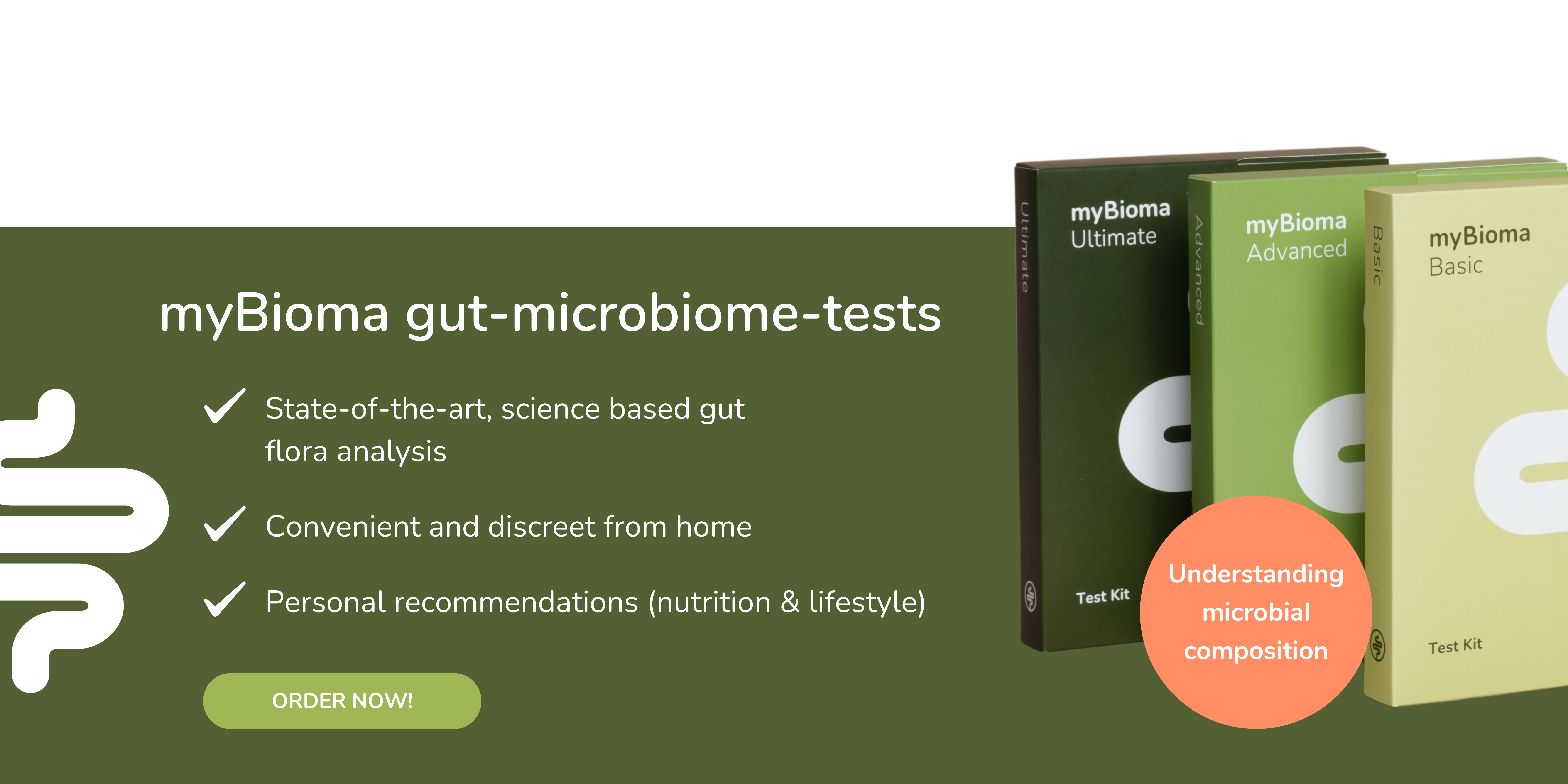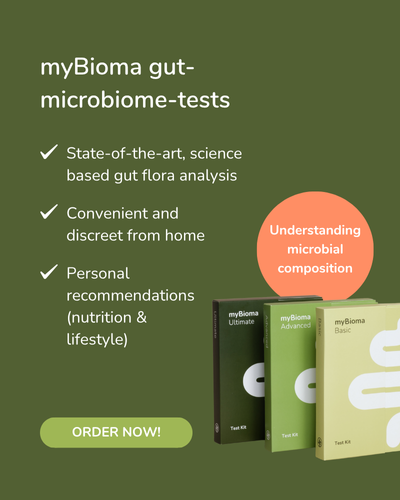Exercise is good, but yoga is better! We repeatedly emphasize how important exercise is for a healthy intestinal microbiome. But did you know that yoga in particular is very popular with your microbiome and can have a positive effect on your intestinal health? We wanted to explore this in more detail and have PhD microbiologist and yoga teacher Eva Maria Hoffmann-Gombotz was asked. Eva herself says: “Yoga is not a trendy star that briefly flickers up in the fitness sky. Yoga is a well-founded science that is thousands of years old.” She uses yoga specifically to improve her clients' intestinal health and tells us in this article how this came about. You will also receive exciting exercises to implement directly!
“As a scientist, why do you practice yoga?” I often hear questions like these. Very often, actually. And the answer is: Because it makes sense . But always in order.
My name is Eva Maria Hoffmann-Gombotz. I am PhD in microbiology, independent speaker for intestinal health and yoga teacher. For many years I studied at the Medical University of Graz Development of colon cancer researched until my love for the intestines made me switch sides. Today I dedicate my life 100% to the topic of intestinal health. I am concerned with a diet that is friendly to the intestinal flora. The influence of lifestyle on our digestion. The connection between stress and intestinal colonization.
With my knowledge, I support companies in strengthening their employees from the center. In seminars and workshops, I bring the latest findings in microbiome research to the world of work, packaged in more digestible bites. Making people fall in love with their gut – that’s my mission. In my courses we pamper the intestines with massages, foods that are friendly to the intestinal flora and through a targeted yoga practice.
Om, for the microbiome
When I advertised my first yoga courses years ago, my participants came to me because of neck tension, back problems or shoulder pain. What is noticeable is that, especially in the last few months, more and more participants have ended up on my mat because they suffer from digestive problems. Of course this is no coincidence.
Corona and home office leave their mark - even in the intestines
On the one hand, the Covid19 pandemic still causes fears and worries. Working in the home office encourages unbridled feasting. And this combination not only affects many people's mood, but also their stomach and intestines.
With yoga therapy for intestinal health
On the other hand, word of my approach to work has gotten around. Over the past three years, I have pooled my skills and meticulously studied scientific articles. I have myself in “Yoga Therapy for Digestive Health” trained and was able to experience first-hand the amazing effect a mindful yoga practice has on the body, mind and intestinal microbiome. That was the birth of “Strong from the middle” . A program that combines intestinal health, nutrition and yoga.
Yoga is a well-founded science that is thousands of years old
Yoga is not a trendy star that briefly flickers up in the fitness sky. Yoga is a well-founded science that is thousands of years old. More and more studies are showing that regularly practicing yoga has a positive impact on health. For example, inflammatory markers are reduced, sleep quality seems to improve, and the immune system benefits enormously. One study found the same benefit as a low-FODMAP diet in patients with irritable bowel syndrome.
Yoga can relax an irritated intestine in different ways:

Conscious deep abdominal breathing can now ensure calm.
Breathing!
During times of stress, breathing becomes shallow and rapid. It mainly occurs in the chest cavity. It's difficult to take a deep breath. It is the sympathetic nervous system, the part of the autonomic nervous system that is responsible for fight or flight, which chases us through everyday life. The muscles of the arms and legs are well supplied with blood. Likewise our hearts. All of this is important if we want to run away from danger. Our intestines, however, look through our fingers. Because there is no chance of adequate digestion, the supply of nutrients to the intestinal epithelial cells, or sitting back and digesting. If this stressful situation becomes the “normal state”, people and their intestines suffer. In my experience this leads to bloating, constipation, diarrhea. Or a combination of all.
Take a deep breath!
The good news: Conscious deep abdominal breathing can now ensure calm. This mindful breathing awakens the chilled brother of the hyperactive sympathetic nervous system: the parasympathetic nervous system. Your tasks are: Rest and Digest (Rest and digest). In my gut-healthy yoga courses, I teach my students what is known as Ujjayi breathing. The inhalation is placed in the stomach. It is important to completely relax the abdominal wall and arch it forward. While exhaling, you visualize fogging up a window pane with the air you breathe. The breath is breathed with closed lips. This causes the glottis to vibrate. This vibration activates the vagus nerve , the dedicated line between the intestines and the brain. We come to rest. We have energy to digest. Abdominal breathing massages the abdominal organs and can counteract digestive problems.
Breathing exercise for a good stomach feeling : Lie on a yoga mat or blanket. Support your head with a flat pillow so that your neck can relax and not be overstretched. Place your palms on your stomach. Close your eyes. Separate the rows of teeth from each other and the tongue from the roof of the mouth. Feel curious about your breath. Does the abdominal wall rise? As you breathe out, let your stomach soften completely. Notice how the abdominal wall sinks back down. Practice for 2 minutes. Then stretch and stretch.

Long-term stress has been proven to change the composition of the intestinal microbiota, meditation can help!
Gut-brain axis
“Yoga for the Gut” is a practice for the gut-brain axis. The brain and intestines have over 100 million nerve cells in constant exchange. The two communicate nonstop. Long-term stress has been proven to alter the composition of the intestinal microbiota. If the residents in the shared apartment in our basement change, this becomes noticeable in the nature of the microbial metabolic products. Our intestinal bacteria play a crucial role when it comes to the balance of brain messengers. These include serotonin, norepinephrine, and dopamine.
With a mindful yoga practice, it is possible to turn more towards the central axis again - to establish a connection with our own center - the intestines come to rest and we also succeed - at least temporarily - in giving the drivers in our brain a break. The aim of conscious intestinal yoga practice is to notice the abdominal pain. Without stiffening up. Without holding your breath. But to accept what is there in a safe space. This relaxation is a “reset” for the gut-brain axis.
Meditation for a good gut feeling: Find a comfortable sitting position. Like leaning against a wall. Close your eyes. With your eyes closed, focus on the tip of your nose. Breathe evenly and calmly, in and out through your nose. Stay for 3-5 minutes. Then squint into the room, shake yourself up and enjoy the pleasant feeling.

Yoga for the intestines influences our digestion in many ways.
Movement!
Lack of exercise, a one-sided, low-fiber diet combined with insufficient fluid intake makes the intestines sluggish. In yoga we also speak of the digestive fire Agni, which goes out. Regular digestion requires muscular strength. Yoga for the intestines influences our digestion in many ways: On the one hand, we strengthen muscle strength, the lymph flow is stimulated and blood circulation is also promoted. The fascial network that holds us together is moistened and gains new flexibility. Through targeted, mindful spreading, stretching and stretching, we keep our fascia supple and create more space for our organs.
In addition, a gut-conscious yoga practice takes care of the strongest muscle in the human body: our jaw. If we work with concentration, we frown. When we are fully committed to something, it is easy to “get stuck in”. From a yogic perspective, the energy is now stagnating in the head area. The neck becomes stiff. The shoulders hurt. In my courses, every yoga unit begins with relaxation exercises for the face - in the interests of intestinal health.
Last but not least, the Psoas major muscle (the muscle of the soul) plays a key role. The psoas is hidden in the lower abdomen and connects the upper and lower body. It is the strongest hip flexor in the human body, with many important functions. It stabilizes the spine and the organs in the abdominal cavity. It promotes blood circulation there, it controls the diaphragm, it massages the lumbar spine and ensures relaxation of the internal organs.
The designation “Muscle of the Soul” This is because the muscle tenses when stressed. This can be done the good old way “Fight or flight” response lead back. Sitting in an office chair all day also causes this muscle to atrophy and shorten. Breathing stops, stomach twists. That's why the focus in my intestinal-healthy yoga classes is on relieving the pressure on the psoas. If the muscle of the soul feels good, the intestines and the person connect.
Classic exercise for a good gut feeling: Sufi circling: Sit cross-legged on a mat and start circling your spine. Start with small circles, allow them to grow larger. Change direction too. Very slowly allow the movement to become smaller and smaller. Above all, enjoy the tiny circles that cannot be seen from the outside.

Our intestinal microbiome needs fiber and fiber.
Nutrition !
When I started looking into one intestinal flora-friendly diet I was excited and fascinated to get to grips with it. Until that moment, I had no idea that I was responsible for billions of bacteria with every single bite that went into my mouth. So it's not just about our human desires!
Our intestinal microbiome needs fiber and fiber. The bacteria love a Mediterranean diet. They have a huge party in the intestines when they eat it predominantly plant-based foods be nourished. As a “thank you” they produce substances that strengthen our intestinal barrier. Benefits our immune system. Our mood increases. Personally, what amazed me most was that there are so many parallels between this intestinal flora-friendly diet and the nutritional recommendations of the ancient yogis. The ancient writings also advocate a plant-based diet and recommend only filling your stomach to 80%.
Eating well-being is therefore possible.
And also to see what effect this has on our intestinal residents. I have one for that Microbiome analysis from myBioma carried out and am very proud of the diversity of my microbiome.
Favorite food for a good stomach feeling: “Eat the rainbow” . Avoid finished products. Watch out for hidden sugar. Drink enough water. Incorporate nuts and legumes into your diet. The more variety, the more fun you give your bacteria.
Positive thoughts !
In my many years of work with the intestines and people for whom they cause problems, I have seen many people despair. There is a lack of confidence in your own body. There is great frustration because, for example, going to a restaurant has become impossible due to stomach problems. Or doing the job. Maintaining social contacts. My yoga sessions for the intestines are not just about movement and breathing, but also about mental strength.
Together we create a safe space where everything is allowed. Anger, annoyance, stomach noises, regeneration and the joy of everything that the body can still do - despite stomach pain.

Dr. Eva Maria Hoffmann-Gombotz – Microbiologist, lecture trainer, yoga teacher.
She has been giving lectures on intestinal health, nutrition and hormones in Austria, Germany and Switzerland since 2013. With her intestinal-healthy seminars and workshops, she takes care of the good gut feeling of employees in Styrian companies. She runs an online yoga studio (Kakini Yoga), has a podcast (Mittel. Punkt) and reads everything she can get her hands on. But most of all cookbooks. Eva Maria Hoffmann-Gombotz likes to talk, laughs a lot and still likes people better than bacteria.
We thank you for the exciting information and are ready to roll out the yoga mat! Are you also interested in an individual gut-healthy yoga program? Contact Eva at info@darmxund.at. You can also find more information on their Homepage . Well then, Namaste for a happy one.







